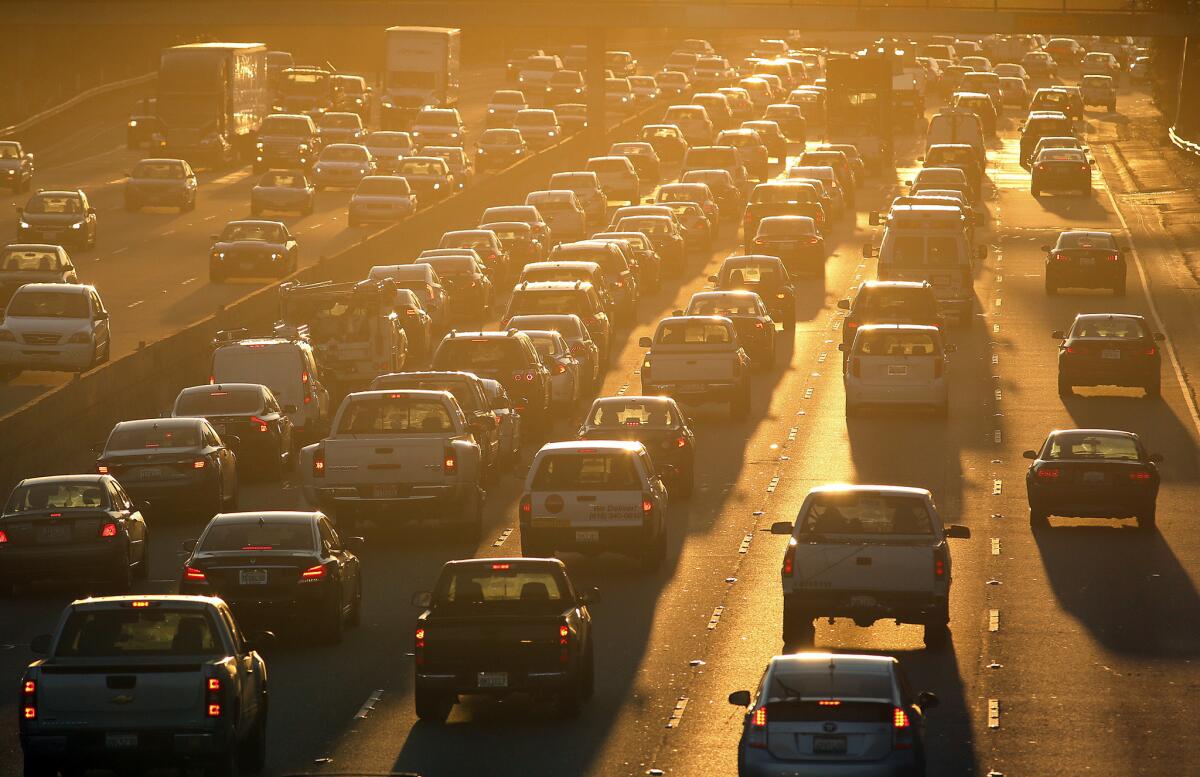Can you hear the chant from the Oval Office? ‘Make America Polluted Again’

- Share via
President Trump’s attack on California’s long-established authority to set air pollution rules stronger than those of the federal government means we’ll see fewer clean cars and more pollution-spewing Trumpmobiles. We can almost hear the chant from the Oval Office: “Make America Polluted Again.”
Relying on a legal theory rejected by two federal courts, the administration claims, in effect, that California never had the authority to set its own standard — a standard that 13 other states have followed — in the first place. Never mind that the authority in question is a centerpiece of the 1970 federal Clean Air Act, and that presidents of both parties have allowed California to exercise its “waiver” more than 100 times to fight smog.
The state claims it will set its own stricter than federal rules anyway, but there’s no guarantee that the California Air Resources Board will be strict enough or will be able to attract every automaker to the table. With the Trump administration also promising to roll back Obama-era rules — which set progressively tougher emissions standards going into effect from 2012 to 2025 — the board made its own deal with Ford, Honda, BMW and Volkswagen in July. The terms are better than what Trump threatens, but it still amounts to a significant weakening of the Obama administration plan.
If the U.S. were to follow through on what was set in motion under President Obama, it would represent the biggest single step any nation has taken to fight global warming. The plan anticipated a 2025 new-car fleet averaging 54.5 miles per gallon in test conditions, 36 miles per gallon on the road. That would save consumers $1 trillion at the pump and, because each gallon of gas we burn adds 25 pounds of carbon dioxide to the atmosphere, it would reduce emissions of the primary global warming pollutant by 6 billion tons.
The Trump rollback, according to leaked reports, would freeze the standard at 2020 levels — roughly 37 miles per gallon under test conditions, 29 miles per gallon on the road. The California Air Resources Board’s separate deal calls for 51 miles per gallon under test conditions by 2026. That doesn’t sound bad, but there are loopholes, such as credits for certain engineering and design features. Instead of emission reductions that pencil out at 5% a year, as under the Obama plan, reductions would fall to just 1.5% a year, by some estimates. And the board’s compromise hasn’t been universally adopted.
Without an ironclad kick in the tailpipe from California (with its allied states, home to a huge car market), there’s no evidence to suggest that the federal government or the auto industry will move aggressively to limit auto pollution and do what we know automakers can do — build cars that are both safe and increasingly efficient. The industry failed to improve gas mileage from 1989 to 2007 because the federal fuel efficiency standard didn’t require improvements. Only after California set CO2 emissions rules under the waiver allowance did automakers take notice.
The attack on California’s waiver authority and on the Obama clean air plan can only hamper the domestic industry’s competitiveness in the long run. While China, the world’s biggest auto market, aims for a 2025 new-car fleet that includes 20% electric vehicles, U.S. carmakers could be running in reverse, thanks to the president. The climate crisis already poses an extreme challenge to our planet, delivering worsening wildfires, droughts, floods, sea level rise and disease. We need every weapon to fight the scourge.
California leads the battle against global warming, just as it has led the fight for 50 years under the Clean Air Act to protect our air and health. As it contests the president’s assault on its waiver authority in court and presses for a separate deal with automakers, it cannot back down. It would be a Pyrrhic victory if the state reclaimed its authority to write stronger air pollution rules only to compromise on the standards for future emissions.
Dan Becker directs the Center for Auto Safety’s Safe Climate Campaign. James Gerstenzang, who covered the White House and environment for the Times, is the campaign’s editorial director.
More to Read
A cure for the common opinion
Get thought-provoking perspectives with our weekly newsletter.
You may occasionally receive promotional content from the Los Angeles Times.









